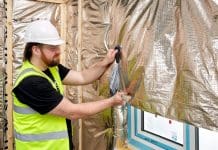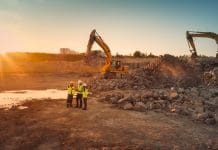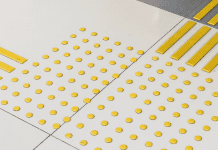After nearly half a century in the industry, David Emery of the Supply Chain Sustainability School looks at the evolution of digital models and the innovations that are driving the democratisation of digital data in construction
“The test of our progress is not whether we add more to the abundance of those who have much; it is whether we provide enough for those who have little.” – Franklin D Roosevelt
The aircraft industry stands accused of being one of the most polluting and least sustainable industries in the world; it is, according to the World Economic Forum, the source of 2.1% of all human-induced carbon dioxide.
But according to the same source, the energy consumed by data centres accounts for even more CO2: some 2.5%. Currently, the world produces 97 trillion gigabytes of data annually, and it is estimated this will double by 2025.
Is this level of emissions from the creation and storage of digital data justifiable? Perhaps so if you believe that the availability of data helps drive efficiency and reduce waste elsewhere. But according to a Gartner study: “40% of enterprise data is either inaccurate, incomplete or unavailable.” Moreover, according to HFS Research: “75% of execs don’t have a high level of trust in their data.”
Reflecting on my early days of developing digital models, I was struck by how I may have inadvertently contributed to this problem; I saw that the digital teams were expending huge amounts of time and energy on creating data-rich and highly accurate BIMs at the behest of clients, but the outputs were – in the main – PDFs and spreadsheets, these being the only formats the clients were able to manipulate!
For too long, the ability to create data-rich digital models was the preserve of highly skilled designers, who had to become adept at using sophisticated software tools. It is said that it takes 10,000 hours to become an expert at something, and it certainly took time for the industry to develop the necessary skills to operate BIM authoring tools to their full capabilities, an issue compounded by the fact that the best-known of these all have their own distinct workflows and capabilities.
Nowadays, though, numerous apps allow people with no knowledge of BIM authoring tools to be able to add data to BIMs without the steep learning curve required of the expert model authors; other apps allow people to extract BIM data for their own specialised purposes.
These apps are, in my opinion, bringing about the democratisation of data, so here are a few that have drawn my attention:
3D Repo: Accessing digital data in construction from the cloud
Tools such as 3D Repo facilitate the sharing of model data in an online platform. One of the key features is in allowing even non-technical personnel to be able to search for and find useful information, without needing to understand the technical aspects of creating the BIM. The company has recently been acquired by Asite, the self-proclaimed “world’s leading data platform for the built environment”.
Buildots: Scanning and controlling site works
Buildots uses scans of the construction site in progress – taken by either an operative walking the site with a scanner on a helmet or even using a robot – and compares those scans with the design models to check progress against the programme and also to identify any discrepancies in the build by comparing the scan data with the original BIM.
Drone surveys
I was staggered to learn recently from Dudley Institute of Technology that drones are now capable of carrying out surveys that are accurate to +/- 0.6mm, a tolerance far more accurate than the industry is used to. The availability of such accurate and detailed information certainly speeds the development of BIMs from which design options can be explored.
Control of plant and equipment
Flannery Plant Hire demonstrates a number of case studies where a combination of GPS and connected software tools facilitate the automation of excavators on-site to ensure accurate soil removal and grading.
Robotic setting out
HP’s Site Print is a robot that prints setting-out information onto concrete floors.
There are many other digital innovations either in use or just over the horizon, anything from swarm robots to additive printing, intelligent design tools, to humanoid robots.
After nearly 50 years in this industry, I think there’s an appetite for change and improvement, the like of which I’ve never witnessed before. We are entering a world of full interconnectivity, big data and artificial intelligence, and it is interesting to speculate whether the increasing reliance on technology and digital data in construction will make it a more attractive sector for young people to consider as a career – or will the industry reach a point where it doesn’t actually need people anymore? When I was at the start of my career in the 1970s, that would have been a ludicrous question, but now I’m nearing the end of it, I’m not so sure!
David Emery
Consultant
Supply Chain Sustainability School
Tel: +44 (0)207 697 1977
info@supplychainschool.co.uk
www.supplychainschool.co.uk
Twitter
LinkedIn
Facebook
YouTube

















